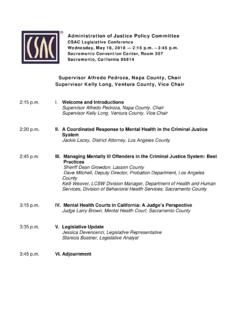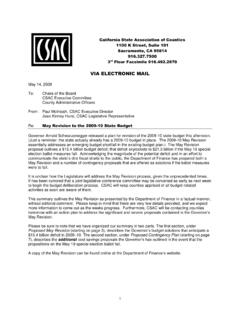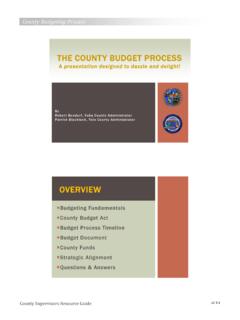Transcription of IHSS Wages and Bargaining Provisions Brief
1 ihss Wages and Bargaining Provisions Brief November 2019 A new County In-Home Supportive Services ( ihss ) Maintenance of Effort (MOE) was established by SB 80 (Chapter 27, Statutes of 2019). The new ihss MOE creates a more sustainable fiscal structure for counties to manage ihss costs and continue to deliver vital services on behalf of the state. Please see CSAC s Overview of 2019-20 County ihss MOE for the full details on the major Provisions of the new ihss MOE including the new MOE amount, inflation factor, and State General Fund commitment. SB 80 also contained several significant Provisions related to MOE adjustments for locally negotiated wage and benefit increases, as well as impasse procedures for collective Bargaining between counties and ihss provider unions. This resource provides an overview of these tools and procedures, some of which continue from the 2017 ihss MOE legislation and others that change.
2 CSAC, CWDA, and CAPA will continue working with the Department of Finance and the California Department of Social Services (CDSS) on implementation and guidance related to these Provisions . Overview of Changes under SB 80 SB 80 continues many of the new collective Bargaining tools and MOE adjustment Provisions that were established by the 2017 ihss MOE legislation. However, there are some notable differences. Below is a table providing Brief highlights of the key consistencies and changes. The full details about all of the below items can be found throughout this document. Consistent with 2017 ihss MOE legislation State approval of rate increases wage supplement tool MOE adjustment calculations Changes in 2019 MOE adjustments for increases in health benefit premiums Impasse procedures/Realignment withholding No immediate changes, but changes in 2022 State/County share of costs in local wage /benefit increases State participation cap State participation above the cap tool State Approval for Changes in ihss Provider Wages and Benefits All counties must meet the requirements of Welfare and Institutions Code to act as or establish an employer of record for ihss and to meet and confer pursuant to the Meyers-Milias-Brown Act.
3 Most counties have established a Public Authority to fulfill these requirements. The state must review and approve the Public Authority rate for Wages , health benefits, and other economic terms of a local Bargaining agreement before the changes can take effect. The same procedures and funding requirements apply for any wage or benefit change that is locally negotiated, mediated, imposed, or adopted by ordinance. The state does not have the authority to approve or deny locally negotiated Wages and benefits, but can review the rate change request for compliance with state and federal law. It is important to note that the state has never denied a rate increase. Counties must provide CDSS with documentation of the County Board of Supervisors approval of the proposed public authority or nonprofit consortium rate.
4 Increases to the hourly wage and benefits will not take effect until both CDSS and the Department of Health Care Services have determined that the increase is consistent with federal law to ensure federal financial participation and CDSS has reviewed for compliance with state law. The rate increases will go into effect on the first day of the month after the month that final approval by the state is granted. A request to change the Public Authority rate must be made at least 60 calendar days, but not more than 90 calendar days, prior to the requested effective date of the change. State Financial Participation in Wages and Benefits Currently, the state will participate in 65 percent of the non-federal share of costs of Wages and health benefits up to $ per hour, which is the current state participation cap.
5 As the state minimum wage continues to increase, the cap on state participation will continue to rise to $ above the increased state minimum wage . The sum of the hourly wage plus the amount of the hourly rate for health benefits establishes the total amount that determines the level of state financial participation. For example, if a county has a provider wage of $ per hour and provides health benefits of $ per hour, then the county would be at the state participation cap. Counties will pay the entire non-federal share of costs for any wage or health benefit increase that is above this cap. However, there is a provision that will allow limited state participation above this cap and that is detailed in the State Participation Above the Cap section. Starting January 1, 2022 On the date that state minimum wage reaches $ per hour, currently scheduled for January 1, 2022, there will be changes to the state participation level.
6 The state participation in the non-federal share of a wage , health benefit, or non-health benefit increase will decrease to 35 percent and the county will then be responsible for 65 percent of the non-federal share of costs. Also on this date, the state participation cap will be eliminated. The state will participate in all approved wage and health benefit increases, no matter how far above the state minimum wage . However, state participation will be at the reduced level of 35 percent of the non-federal share of costs. This change in state participation applies to all increases in Wages or benefits that go into effect on or after January 1, 2022. Increases that are negotiated prior to January 1, 2022, but that go into effect on that date or later will be subject to the new reduced state participation level.
7 Below is a table that shows the state minimum wage and state sharing through 2022. Year State Minimum wage State Participation Cap State Share of Non-Federal Costs Under the Cap January 1, 2019 $ per hour $ 65% January 1, 2020 $ per hour $ 65% January 1, 2021 $ per hour $ 65% January 1, 2022 $ per hour No cap 35% MOE Adjustments for wage Increases The County ihss MOE will be adjusted for the annualized cost of increases in provider Wages that are locally negotiated, mediated or imposed on or after July 1, 2019, including those increases that result from being adopted by a local ordinance. The MOE adjustment shall reflect the County s share of costs for the wage increase. The annualized MOE adjustment will be calculated based on the county s 2019-20 paid ihss hours, any inflation factors that have occurred to that point, and the appropriate cost-sharing ratio.
8 The annual four percent inflation factor will apply to any MOE adjustments. CSAC, CWDA, and CAPA are engaged in ongoing discussions with the Administration related to guidance on MOE adjustments for wage increases. wage Supplement Counties have the ability to negotiate a wage increase as a wage supplement, which is a specified amount that is in addition to the county provider wage and is subsequently applied on future dates. Consistent with the 2017 ihss MOE legislation, SB 80 does not make any changes to a counties ability to negotiate a wage supplement, how the wage supplement works, or create an end date for use or applications of the wage supplement. All counties, whether at minimum wage , above minimum wage , or above the state participation cap can use the wage supplement tool. The wage supplement can also be used in conjunction with the state participation above the cap tool.
9 When submitting a rate increase for approval, counties must specify in both the collective Bargaining agreement and in the rate change request that the wage increase is a wage supplement. When a wage supplement is first negotiated and applied, there is an adjustment to the County ihss MOE for the county share of the wage supplement. A wage supplement will be subsequently applied when the state minimum wage equals or exceeds the county provider wage absent the wage supplement amount. For subsequent applications of the wage supplement, there is no new adjustment to the County ihss MOE. The state participation level in the non-federal costs of the wage supplement depends on if the county is below the state participation cap, if the county is using a tool to garner state participation above the cap, and if the wage supplement goes into effect prior to January 1, 2022 (when the state participation level changes).
10 Example of wage Supplement In 2020, if a county s provider wage is $ per hour and the county negotiates a $ wage supplement, the amount the ihss provider is paid would increase to $ per hour ($ provider wage plus $ supplement) and there would be an MOE adjustment for the county share of the $ increase. When the state minimum wage increases to $ per hour in 2021, it passes the provider wage absent the wage supplement of $ per hour and the wage supplement would be subsequently applied, bringing the total wage to $ per hour ($ provider wage from new minimum wage plus $ supplement). There would be no new MOE adjustment for this subsequent application of the $ wage supplement. Below is a table that demonstrates how this example would work. 1/1/2020 1/1/2021 1/1/2022 State minimum wage $ $ $ County provider wage $ $ $ wage supplement $ $ $ Total amount ihss provider is paid $ $ $ State Participation Above the Cap (10 Percent Over Three Years) The tool that was established by the 2017 ihss MOE legislation and allows the county to secure state participation in the non-federal share of costs of a wage or health benefit increase for counties that are above the state participation cap continues under SB 80.










